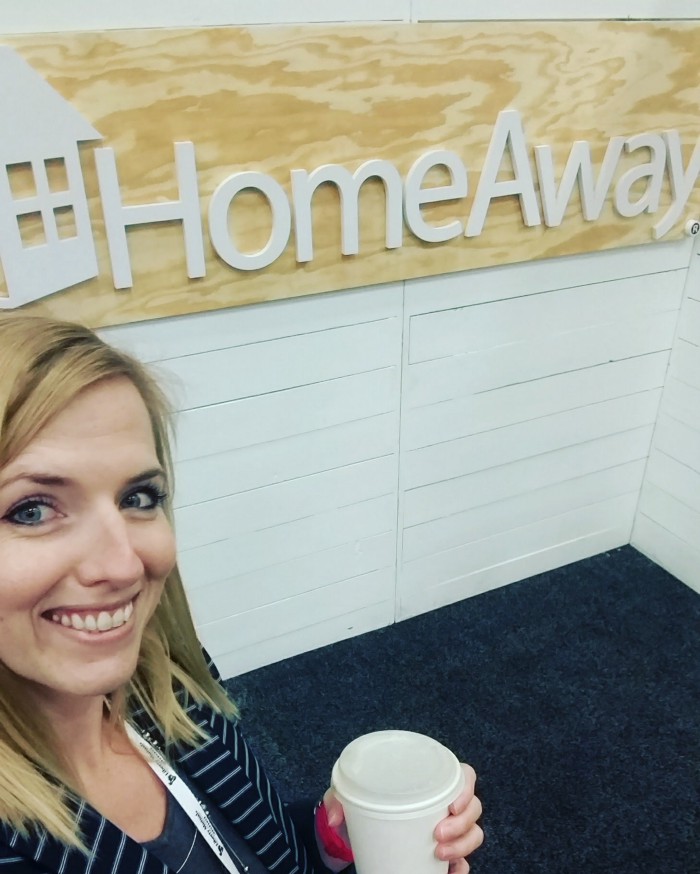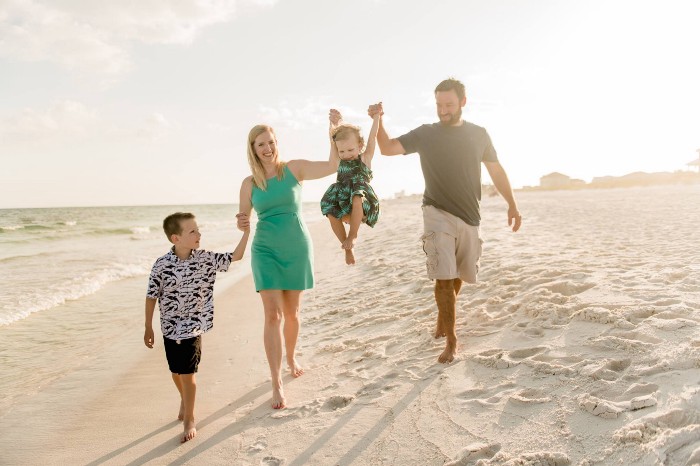Search Contract Jobs*
Hello!
You’re now leaving the Expedia Group careers site and will be directed to our supplier partner’s website to explore and apply for contract job opportunities with Expedia Group. The website is operated by Expedia Group’s employment partner.
*currently only offered in USA & UK
Jobs
Search Expedia Group Jobs
Stay At Home Mom & Navy Wife Back to Software Engineer: A Returnship Story
“Nothing.” That’s the answer Jeff, my husband, gave me after he rejected every job posting I sent his way, and I finally asked him what he wanted to do next. In 2016, we found out that his time as a Navy F/A-18 pilot would be coming to an end in seven months after spending 11 years in the Navy. I could understand his answer. When you get to do your dream job, where do you go next?
“So…does that mean, I can go back to work?” I asked.

Let’s rewind a bit and start this story 13 years earlier as we were finishing college.
Chapter 1: Finding a Job After College as a Navy Wife
In 2005, Jeff was in his senior year at the Naval Academy and had already received news that he’d be going to flight school after graduation and our wedding. I actually targeted interviewing for DoD companies because if my husband was going to be in the Navy and we’d be moving around to different bases — what is the one other type of company that will also be available to hire me? DoD.
Or so I thought.
In our first move from Washington DC to Pensacola, FL, I soon found out my plan wasn’t going to work. There were no DoD companies in the Pensacola area needing software engineers. However, 1.5 hours away there was a DoD contractor looking for a software engineer. I figured something was better than nothing, so I interviewed, then waited…for three months. They told me they would hire me as soon as they got the funding. But I couldn’t stand it anymore. And thinking about the commute I’d have to make daily for something I didn’t love started to sink in during the waiting. So I started looking for any software engineering or programming jobs in the area and found one. I interviewed and was hired quickly after.
The company was a small telephony services firm that helped other companies set up their interactive voice response systems and agent desktop call center soft phones. Not thrilling work, but something new for me to sink my teeth into. After nine months of working there, the Navy moved us again — this time to Meridian, MS. The good news with this move? I got to keep my job and work from home. With the two moves that came after the move to MS (18 months in MS; 10 months in Lemoore, CA; then Virginia Beach, VA in 2010), I was fortunate enough to continue to work from home. When we moved to Virginia, I did start to travel more to install the systems I was building. I spent a few weeks in Atlanta, Miami, and even three months in Columbia, SC.
This type of job was working for me at the time. Jeff’s daily schedule was always so crazy that working from home allowed me to see him as much as possible. When he did have to go on month long detachments or even his seven month deployment in 2010, I could travel to make the time apart seem to go by faster.
He came home from deployment — and I got pregnant.
Chapter 2: Stay at Home Mom
In September 2011, we became a family of three and it was then that the decision was made that I would become a stay at home mom (SAHM). Jeff’s work schedule was erratic and I also didn’t love the job I was doing enough to spend my paycheck on a nanny or childcare. With another move ahead of us back to Lemoore, CA after three years in VA and a plan to have more kids, I chose to continue the SAHM gig for a while. We had our daughter in November 2015.

I honestly didn’t think I’d ever go back to being a software engineer.
Military life is hard. Being a military spouse is hard. The life doesn’t allow spouses to really pursue their own careers without a lot of compromises. Some spouses get lucky and they get stationed in the right cities for their careers or maybe they become successful entrepreneurs and can live wherever. But that isn’t the norm for most military wives. We give up our careers for our spouse’s career.
Chapter 3: Finding a Job in Software Engineering After Five Years as a SAHM
After five years being a SAHM with now two kids and 11 years of being a military family, this change in our lives was going to be super exciting. It was the first time in our adult lives that we could pick where we wanted to live; I could pick where I wanted to work and only move when we wanted. It was liberating.
While we were in Austin for a family event, I met up with some college friends and brought up the idea to a friend who had been at HomeAway for a few years. I asked what it would take to re-enter the software engineering market and if he thought it was possible after such a long time off. He was optimistic that I could get back into it and even helped me with the application process and referred me.
But then reality started to sink in.
I hadn’t kept up with any programming skills besides a few websites I helped friends put together, and I would have to do a technical interview. Technical interviews in college gave me anxiety and I was prepared for them. This was a whole new level of anxiety and stress. After the initial recruiter interview, I knew a technical phone screen was next.
I had been writing code since high school; it was part of me. Like playing an instrument or learning a language, it was something I would never really forget. But just like picking up an instrument after years of not playing or speaking a language you haven’t spoke in years, I was rusty with my programming skills. It was frustrating.
I immediately downloaded everything I needed to program on my laptop and found a few coding exercises online. I even tried to find old programs I wrote in college on an external hard drive! I spent a few nights before the technical phone screen trying to get my coding skills back.
Awful.
The only word I could use to describe that first technical phone screen. It did not reflect what I could do and it made me upset. I was so upset at myself with my performance that I spent the two hours after it solving the coding problem I was given several different ways until I was satisfied with myself.
The recruiter called me the next day and I was expecting bad news. However, she understood that taking five years off in a technical position can be hard and gave me another opportunity. She even gave me another week to prepare, which I totally took full advantage of! While my kids were at school or sleeping, I was looking all over the internet for coding challenges that I could use to prepare myself. I even spent all weekend at Starbucks and told my husband I’d be back when my battery ran out.
I was not giving up on this new life I wanted for us.
Two technical phone screens later (that went so much better), I got an invitation to come onsite to interview. While the onsite interviews were just as challenging, it was all worth it. I ended up getting an offer a week later to join HomeAway in Austin.
We moved to Austin in Jan 2017 and lived happily ever after? Nope. This isn’t a fairytale. The story doesn’t quite end there.

Chapter 4: Re-entry is Hard
First, I had to learn how to use tools that I didn’t have experience with using; either because I was at a small company where I was the only Java developer or was a new tool that came out while I was a SAHM. Tools like GitHub, IntelliJ IDEA (and the keyboard shortcuts!), Maven, Jenkins, Docker, Splunk, AWS…
Oh, and I had to learn about all the updates from Java 8 like lambda expressions, functional interfaces, all the new syntactic sugar….
It felt like the new things to get back up to speed would never end.
On top of all of that, I had to learn about my team’s apps. You’d think that might be the simplest step; however, I am on the Experimentation Platform team at HomeAway. We are the team that builds the tools for all the other teams to enable their A/B testing. So while I had to understand our apps, I also had to understand how data got captured and all the different sources that it came from on both the traveler side of our business along with our partners (or homeowners). I also had to learn basic statistics to understand what our tools were even doing. Then understand how all the teams used the tools.
It is very common to come to a new company and not understand their business fully. I did it with every job I’d ever had. That’s part of the fun! However, wrapping my head around all the new information at once and helping my family get use to the new city and routine….it all made life a tad stressful.
After many tutorials, chats, tech talks, and time — about three to four months — I finally felt like I broke out of the fog of re-entry. I was finally contributing to our codebases, our conversations, and our feature enhancements. I felt like I finally rediscovered my skills as a software engineer.

Chapter 5: The Future of Re-entry
After my experience, I constantly ask myself loads of questions. What if I didn’t have the networking connections I had in the tech industry? What if my friend wasn’t as optimistic about my re-entry possibilities? What if we could develop programs that are geared towards re-entry in tech? What if it was the norm for tech companies to have these programs?
Since I started at HomeAway, they have made changes on how they onboard incoming career hires. They now offer a two week program called Camp HomeAway which is a condensed version of what they give to recent grad hires (HomeAway University). They teach them about the tech stack and give an intro to all the different platform teams. This definitely shortens the on boarding time for incoming engineers and a lot of companies have orientation programs like Camp HomeAway. But for re-entry engineers who need a little bit more time to get their skills back up to speed or maybe learn tools they haven’t used before, shouldn’t there be more?
In 2017, I was fortunate enough to go to The Texas Conference for Women, an annual conference in Austin “that provides connection, motivation, networking, inspiration and skill building for thousands of Texas women each year.” (https://www.txconferenceforwomen.org/about/)

When scouring the sessions to see what I wanted to attend, I noticed a panel discussion about being a woman in tech. I made that a priority immediately. However, when I attended the discussion, it didn’t make me feel encouraged. It made me feel disappointed and enraged. On the topic of how to have kids and grow your career, the panelists all talked about getting childcare to avoid having to stop working. It’s disappointing to me coming from being a SAHM that this is the solution the panelists were giving.
I never regretted pausing my career to be with my son and daughter in their early years and I never will.
So why is the answer the panelists gave still the solution for women in tech? Why can’t there be another way? Why can’t we be moms and be present fully for the first few years of our kids lives and come back to the workforce without being penalized?
There is a retention problem in the tech industry for women in mid-career roles. We haven’t fixed it yet and I know there is more than one cause for it. I believe a majority of retention is due to starting families. Our maternity leave durations have increased, which is progress, but is it enough? I don’t think it is. I believe we could do more. We need to have more opportunities geared toward women wanting to return back to tech after they take time off from their career.
Returnship programs have been popping up and that’s a good first step. But they aren’t prevalent. If we want to change the numbers of women in tech, we have to do something about re-entry. The industry has put so much focus on getting girls in STEM and women to apply for tech majors in college and those numbers have seen amazing progress in the last few decades. When are we going to start looking at the retention problem for mid-career women?
Chapter 6: Be a Part of the Change
Re-entry into software engineering is hard. My hope is to let other SAHMs with tech backgrounds know they aren’t alone and that it is possible to be successful at re-entry (and that it gets better with time!). Moreover, I want to start a discussion about how returnships or re-entry programs should be a norm in our industry. Does your company have a returnship or re-entry programs? Are they successful? What worked and what didn’t? Let’s share these ideas so we can learn from each other!

Chapter 7: 2021 at Expedia Group
Since I wrote the original 6 chapters of this blog back in Oct 2018, I was encouraged to form a pitch from several HomeAway leaders on how we could create a returnship program. And not just at HomeAway (which went under a name change to Vrbo since) but more broadly at Expedia Group.
I gave the pitch to a handful of leadership folks across many different functions in December 2019 and it was well received. In early 2020, the effort was picked up by our Talent Attraction team. However, the pandemic halted all hiring initiatives at Expedia Group and unfortunately this was put aside.
While travel has been recovering in 2021, so has Expedia Group’s hiring initiatives and especially those which would increase inclusion and diversity. I began resurfacing my pitch and focused my efforts with the leadership of Women at Expedia Group Learning and Leading (WELL), our women- focused Inclusion Business Group (IBG). With a fellow returner as the Global President of WELL, Anne Smith, and many supportive board members, it became an official goal of WELL to enable a returnship program.
Today, I am so proud that I can announce the official returnship program at Expedia Group, Return Ticket, is launching in partnership with Path Forward! This truly was a combined effort with help from our Recruiting and Talent Attraction teams, WELL, and the many leaders that have stepped up to be involved.
To apply to Return Ticket, please visit this page.
I do want to take a moment to thank everyone who was a part of the journey. First, Seth Hodgson, my manager from when I wrote the initial blog, who encouraged me to share my story and truly bring my whole self to work. Mike Broadway, a former influential engineering leader at HomeAway, for encouraging me to create a pitch and wanting to hear it to help this effort. Dylan Mankey, my current manager, for giving me the time to do this work and encouraged me to apply for an internal coaching program to focus on the goal with a coach. My coach, Anneliese Pickard, for asking me all the right questions and keeping me accountable to my goal. Tiffany Lee, former Expedia Group Global Employer Brand Manager, who led the initial talent attraction efforts in 2020. Nina Huang, who helped in the 2020 efforts, continued to advocate for the program, and made the connections that got this program off the ground today. Anne Smith, Global President of WELL, for making this an official goal for WELL and being a partner with all the effort behind the scenes. Paulo Sosa, Director of NORAM Technology Recruiting, for seeing the potential of this program and worked tirelessly to get it launched. And finally, thank you to the team at Path Forward, we could not do this work alone and without your guidance. I’m thankful for all you do in promoting, advocating, and partnering with returnship programs across the industry.


